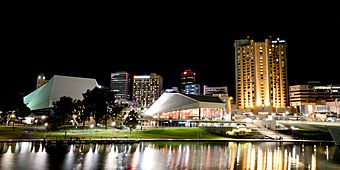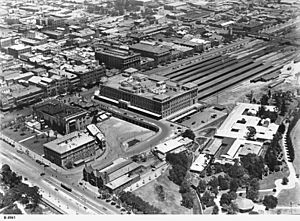Adelaide Festival Centre facts for kids

Adelaide Festival Centre at night with the River Torrens in the foreground
|
|
| Address | King William Road Adelaide, South Australia |
|---|---|
| Coordinates | 34°55′10″S 138°35′52″E / 34.91944°S 138.59778°E |
| Owner | Adelaide Festival Centre Trust |
| Type | Performing arts centre |
| Capacity | Festival Theatre: 2,000 Dunstan Playhouse: 590 Space Theatre: 350 Her Majesty's Theatre: 1,009 |
| Construction | |
| Opened | 2 June 1973 |
| Architect | Hassell |
The Adelaide Festival Centre is a huge place for arts and performances in Adelaide, South Australia. It was the first big arts centre in an Australian capital city. Built in the early 1970s, it was designed by Hassell Architects.
The main part, the Festival Theatre, opened in June 1973. Other parts of the centre and the Festival Plaza opened soon after. The centre is about 50 metres north of North Terrace and King William Road. You can spot it by its two white dome roofs.
The complex has several theatres, including the Festival Theatre, Dunstan Playhouse, and Space Theatre. It also has art galleries and spaces for events. The Adelaide Festival Centre Trust manages the centre. This group helps bring art, culture, and performances to life. They also keep the buildings and facilities in great shape. The centre hosts the famous Adelaide Festival and many other big festivals all year.
The centre was built on land between Elder Park and Parliament House. Some old buildings were taken down to make room for it. The outdoor plaza area has been redeveloped since 2016. The theatre spaces have stayed open during this time. The car park and plaza are now finished, as is Festival Tower.
Contents
Building the Festival Centre
Why it was Built
In the 1960s, the Adelaide Festival of the Arts became very popular. It grew too big for the city's existing venues. People wanted a new "Festival Hall" to host these events. In 1964, a law was passed to build the Festival Theatre.
At first, the Carclew building in North Adelaide was suggested. This building was bought by the Adelaide City Council for the new hall. Later, the idea grew into a larger "Festival Centre" with many smaller venues. This was thanks to Premier Don Dunstan.
The Lord Mayor of Adelaide, Robert Porter, helped raise money from the public. People donated a lot, and the extra money was used to buy artworks for the new building. The design was praised as a big step forward in modern architecture. Architects John Morphett and Colin Hassell were key designers. They even visited theatres in the US and Europe for ideas.
How it was Built
Before the centre was built, some old buildings were removed. These included the Adelaide City Baths and the Government Printing Office. The site also had the Elder Park Hostel, which was used by migrants. The land is also known to be the historical land of the Kaurna people.
The Adelaide Festival Centre was built in three stages from 1970 to 1980. The main building, the Festival Theatre, was finished in 1973. It cost about $10 million. On June 2, 1973, Prime Minister Gough Whitlam officially opened it. The Playhouse (now Dunstan Playhouse), Space Theatre, and Amphitheatre were built next. The whole complex was completed for $21 million. The Festival Plaza was finished in March 1977.
Outdoor Art and Spaces
The Festival Plaza has a large outdoor artwork by German artist Otto Hajek. It's called Adelaide Urban Iconography. This artwork was designed to blend sculpture with the building. It included colourful shapes and cement forms. It was meant to have fountains, plants, and lighting. This would encourage people to enjoy the space.
Other sculptures were also placed outside. One famous one is Tetrahedra by Bert Flugelman. This stainless steel sculpture is also known as Mall's Balls. When the plaza opened in 1977, people had different opinions. Some thought it was empty, but it was seen as an important example of environmental art.
(From left-to-right, starting SE):
Background: (SE): Government House, The Myer Centre, (S): Parliament House, Dame Roma Mitchell Building (SW): Adelaide railway station/Casino/Hyatt Hotel
Foreground: (SE): Southern Plaza, (S-to-W) City Sign
Background:(W-to-N): Adelaide Festival Centre: The Dunstan Playhouse, The Space Theatre, The outdoor amphitheatre, The Festival Theatre
Foreground:(W-to-N): Southern Plaza
Background:(N-to-NE): The Festival Theatre (northern) Plaza, (NE-to-E): Trees along King William Road
Foreground:(N-to-E): Stairs from Southern Plaza down to Festival Theatre Plaza, and Southern Plaza.
Plaza Redevelopment
Over the years, the plaza's painted surfaces and fountains were not kept up. It also didn't attract many people. In 1987, a fountain was removed as part of an upgrade.
In 2002–2003, the area around the centre was changed a lot. The Festival Plaza was redesigned. A pedestrian bridge was built, but the plaza became somewhat isolated.
In 2013, the government announced more changes. Hajek's artwork would be removed and replaced. Some people thought removing such an important artwork was wrong. However, not everyone in the art world or the public was sad to see it go.
Since 2016, the Plaza has been redeveloped as part of the Riverbank Precinct project. The new public plaza, called the Public Realm, was completed. Office buildings and shops were also finished. The original architects, Hassell, worked with other firms on the new design. Festival Tower, located next to the station, was also completed in 2024.
How the Centre is Run
The Adelaide Festival Centre Trust was set up in 1971. This group is in charge of the centre. They report to the Minister for the Arts. The Trust is responsible for encouraging arts and culture. They also manage and maintain the theatres, including Her Majesty's Theatre.
Douglas Gautier became the CEO and artistic director in 2006. In July 2017, the Trust bought Her Majesty's Theatre. As of October 2024, Karlene Maywald is the chair of the Trust. Douglas Gautier announced his retirement in October 2024, planning to leave in the second half of 2025.
The Venues
The Adelaide Festival Centre has several theatres and galleries. It also has spaces for events and offices.
- Festival Theatre is the biggest theatre in Adelaide. It can seat almost 2,000 people. It's used for plays, concerts, graduation ceremonies, and other community events. Its large backstage area makes it one of the biggest stages in the Southern Hemisphere. It also has a special pipe organ called the Silver Jubilee Organ.
- Dunstan Playhouse is a smaller theatre. It seats 620 people on two levels. The State Theatre Company has been based here since 1974. They use the theatre, rehearsal rooms, and workshops. It was renamed after Don Dunstan.
- Space Theatre is a flexible studio theatre. It doesn't have a fixed stage or seats. This means it can be set up in many ways. It can be a theatre in the round or a cabaret venue. It seats between 200 and 350 people.
- Her Majesty's Theatre is a theatre on Grote Street that seats 1,500 people. It first opened in 1913. It was extensively rebuilt from 2018 to 2020 to become a modern venue.
- Artspace Gallery is a space for art exhibitions.
- The Terrace is an outdoor area. It used to be called the Amphitheatre. It overlooks Elder Park and the River Torrens.
- Artspace Gallery and QBE Galleries are other exhibition spaces.
What Happens Here
The Adelaide Festival Centre is home to many top performance groups in South Australia. These include the Adelaide Symphony Orchestra, State Opera South Australia, and Australian Dance Theatre.
The centre hosts the Adelaide Festival. It also presents many other big festivals throughout the year. These include the Adelaide Cabaret Festival, OzAsia Festival, DreamBIG Children's Festival, Adelaide Guitar Festival, and the First Nations art exhibition Our Mob. Our Mob also gives out awards. It started around 2008 and has grown to include Our Words and Our Stories. As of 2025, Celia Coulthard is the First Nations curator.
Getting There
You can get to the Festival Centre by bus or train. The Adelaide railway station is right next door. A short tram line to the Festival Centre opened in October 2018.
| Preceding station | Adelaide Metro | Following station | ||
|---|---|---|---|---|
| Terminus | Glenelg tram line
Weekends and event days only
|
Rundle Mall
towards Moseley Square, Glenelg
|
||


